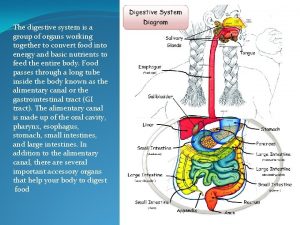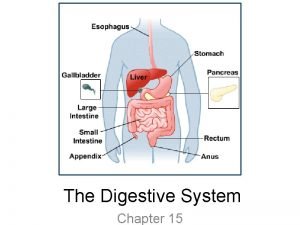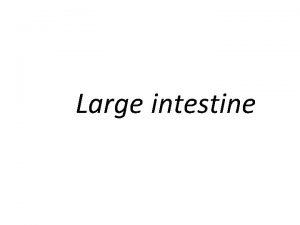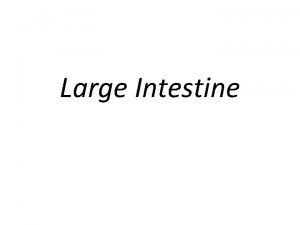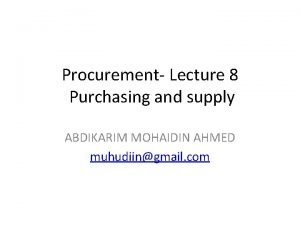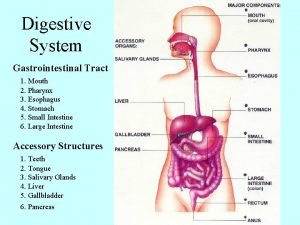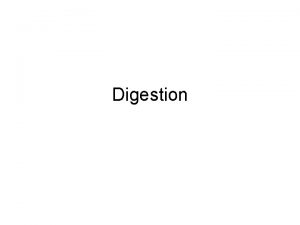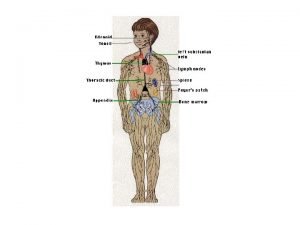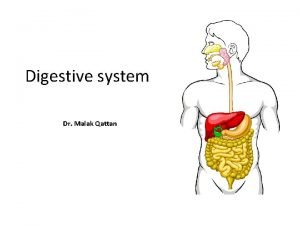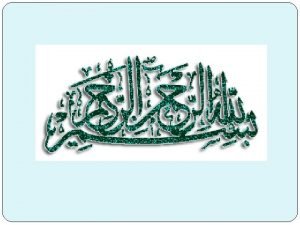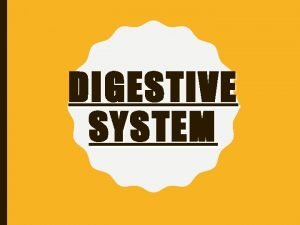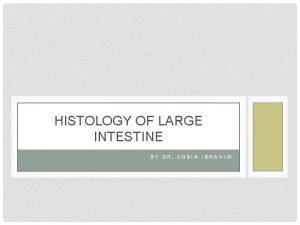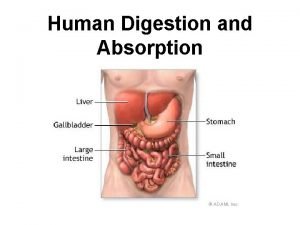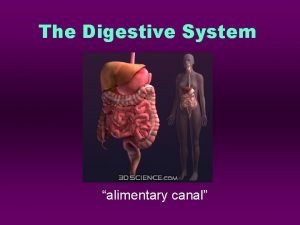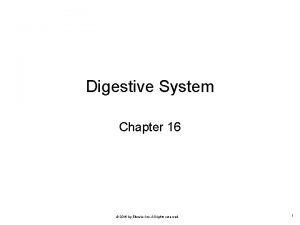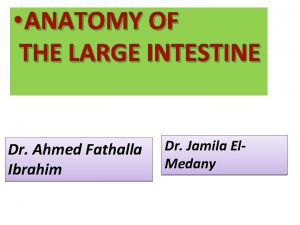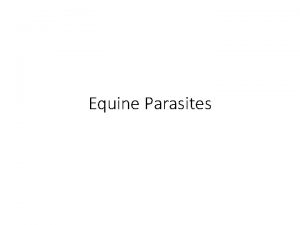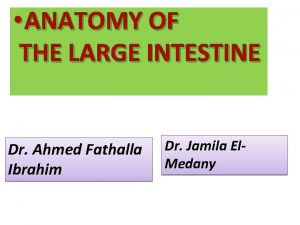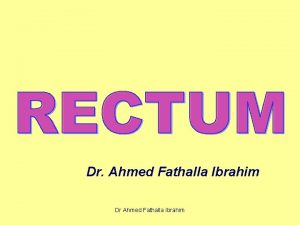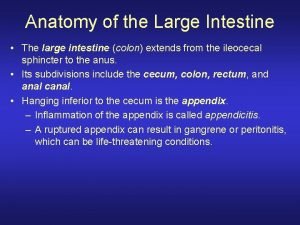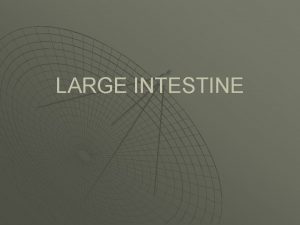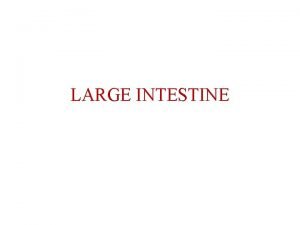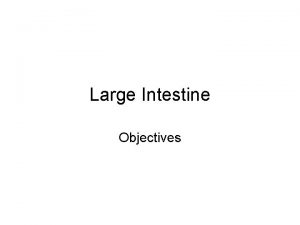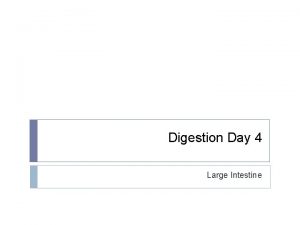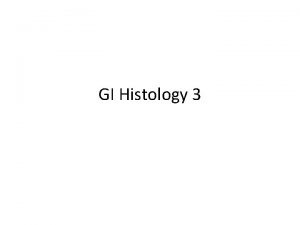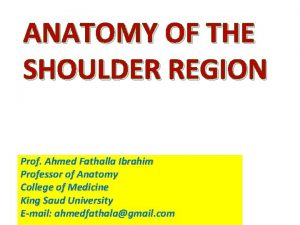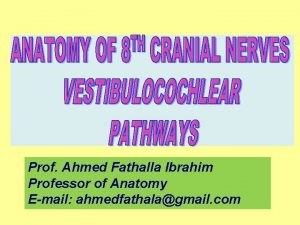ANATOMY OF THE LARGE INTESTINE Prof Ahmed Fathalla






















- Slides: 22

• ANATOMY OF THE LARGE INTESTINE Prof. Ahmed Fathalla Ibrahim Professor of Anatomy College of Medicine King Saud University E-mail: ahmedfathala@hotmail. com

OBJECTIVES At the end of the lecture, students should: q. List the different parts of large intestine. q. List the characteristic features of colon. q. Describe the anatomy of different parts of large intestine regarding: the surface anatomy, peritoneal covering, relations, arterial & nerve supply.

PARTS OF LARGE INTESTINE q. CECUM q. APPENDIX q. ASCENDING COLON q. TRANSVERSE COLON q. DESCENDING COLON q. SIGMOID COLON q. RECTUM q. ANAL CANAL ABDOMEN PELVIS PERINEUM


CHARACTERISTICS OF COLON (NOT FOUND IN RECTUM & ANAL CANAL) 1. Teniae coli: 3 longitudinal muscle bands 2. Sacculations (haustra): teniae coli are shorter than large intestine 3. Epiploic Appendices : short peritoneal fold filled with fat

PERITONEAL COVERING q PARTS WITH MESENTERY: 1. Transverse colon 2. Sigmoid colon 3. Appendix 4. Cecum q RETROPERITONEAL PARTS: 1. Ascending colon 2. Descending colon 3. Upper 2/3 of rectum q PARTS DEVOID OF PERITONEAL COVERINGS: 1. Lower 1/3 of rectum 2. Anal canal

SURFACE ANATOMY Right hypochondrium Right lumbar region Umbilical region Left hypochondrium Left lumbar region 2/3 Mc. Burney’s point ASIS Epigastrium 1/3 Right iliac fossa Hypogastrium Left iliac fossa

APPENDIX Surface Anatomy The base of appendix is marked by Mc’Burney’s point: A point at the junction of lateral 1/3 & medial 2/3 of a line traced from right anterior superior iliac spine to umbilicus

APPENDIX q q Opening: at posteromedial aspect of cecum, 1 inch below ileocecal junction Positions: 1. Retrocecal most common 2. Pelvic 3. Subcecal 4. Preilieal 5. Postileal: least common

RELATION BETWEEN ORIGIN & SUPPLY q. Origin: Midgut (endoderm) q. Artery: Superior Mesenteric q. Nerve: Autonomic: Sympathetic + vagus q. Origin: Hindgut (endoderm) q. Artery: Inferior Mesenteric q. Nerve: Autonomic: Sympathetic + pelvic splanchnic nerves Left 1/3 Right 2/3 q. Origin: ectoderm q. Artery: inferior rectal q. Nerve: Somatic: inferior rectal Lower part of anal canal

RELATION BETWEEN EMBRYOLOGICAL ORIGIN OF GUT & ITS ARTERIAL SUPPLY

VENOUS DRAINAGE OF GUT • Veins draining gut form the portal circulation • All veins finally end into portal vein which enters the liver

CECUM – ASCENDING & DESCENDING COLONS (ANTERIOR RELATIONS) q. Coils of small intestine q. Greater omentum q. Anterior abdominal wall

1 2 3 5 4 6 1: Iliohypogastric nerve; 2: Ilioinguinal nerve; 3: lateral cutaneous nerve of thigh 4: Femoral nerve; 5: Genitofemoral nerve; 6: Obturator nerve P. M. = psoas major; Q. L. =quadratus lumborum; I. =iliacus; T. A. = transversus abdominis; I. V. C. =inferior vena cava; A. A. =abdominal aorta

CECUM – ASCENDING & DESCENDING COLONS (POSTERIOR RELATIONS) q. Cecum: 1. Psoas major 2. Iliacus q. Ascending colon: 1. Iliacus 2. Quadratus lumborum q. Descending colon: 1. Left kidney 2. Quadratus lumborum 3. Iliacus 4. Psoas major

RALATIONS OF TRANSVERSE COLON Anterior: greater omentum, anterior abdominal wall Inferior: coils of small intestine Superior: liver, gall bladder, stomach Posterior: 2 nd part of duodenum, pancreas

COLIC FLEXURES Position: higher Angle: more acute Hepatic flexure Splenic flexure

RECTUM q Beginning: as a continuation of sigmoid colon at level of S 3. q Termination: continues as anal canal, one inch below & in front of tip of coccyx. Its end is dilated to form the rectal ampulla. q Length: 13 cm(5 inches)

RELATIONS OF RECTUM IN PELVIS MALE PELVIS q. Anterior: seminal vesicles, posterior surfaces of urinary bladder & prostate gland q. Posterior: sacrum & coccyx R FEMALE PELVIS q. Anterior: posterior wall of vagina q. Posterior: sacrum & coccyx R

QUESTION 1 q. In which one of the following regions lies Mc. Burney’s point? 1. Right iliac fossa 2. Hypogastrium 3. Right lumbar region 4. Umbilical region

QUESTION 2 q. Which one of the following parts of large intestine is found in the pelvis? 1. Transverse colon 2. Anal canal 3. Rectum 4. Cecum

THANK YOU
 Ahmed fathalla
Ahmed fathalla Esophagus stomach small intestine large intestine
Esophagus stomach small intestine large intestine Main functions of small intestine
Main functions of small intestine Muscle of large intestine
Muscle of large intestine Large intestine
Large intestine Colon anatomy
Colon anatomy Ahmed muhudiin ahmed
Ahmed muhudiin ahmed Characteristics of water soluble vitamins
Characteristics of water soluble vitamins Git layers
Git layers Digestive system enzymes chart
Digestive system enzymes chart Lymphoid tissue in large intestine
Lymphoid tissue in large intestine Dr malak
Dr malak Plica semilunaris large intestine
Plica semilunaris large intestine Bile and pancreatic juices are secreted in the
Bile and pancreatic juices are secreted in the Enteroendocrine cells
Enteroendocrine cells Mash, grind, mix and tear food.
Mash, grind, mix and tear food. Lymphoid nodule colon
Lymphoid nodule colon Copyright
Copyright Rugae
Rugae Part of large intestine
Part of large intestine Divisions of the large intestine
Divisions of the large intestine Appendix
Appendix Strongylus vulgaris
Strongylus vulgaris

